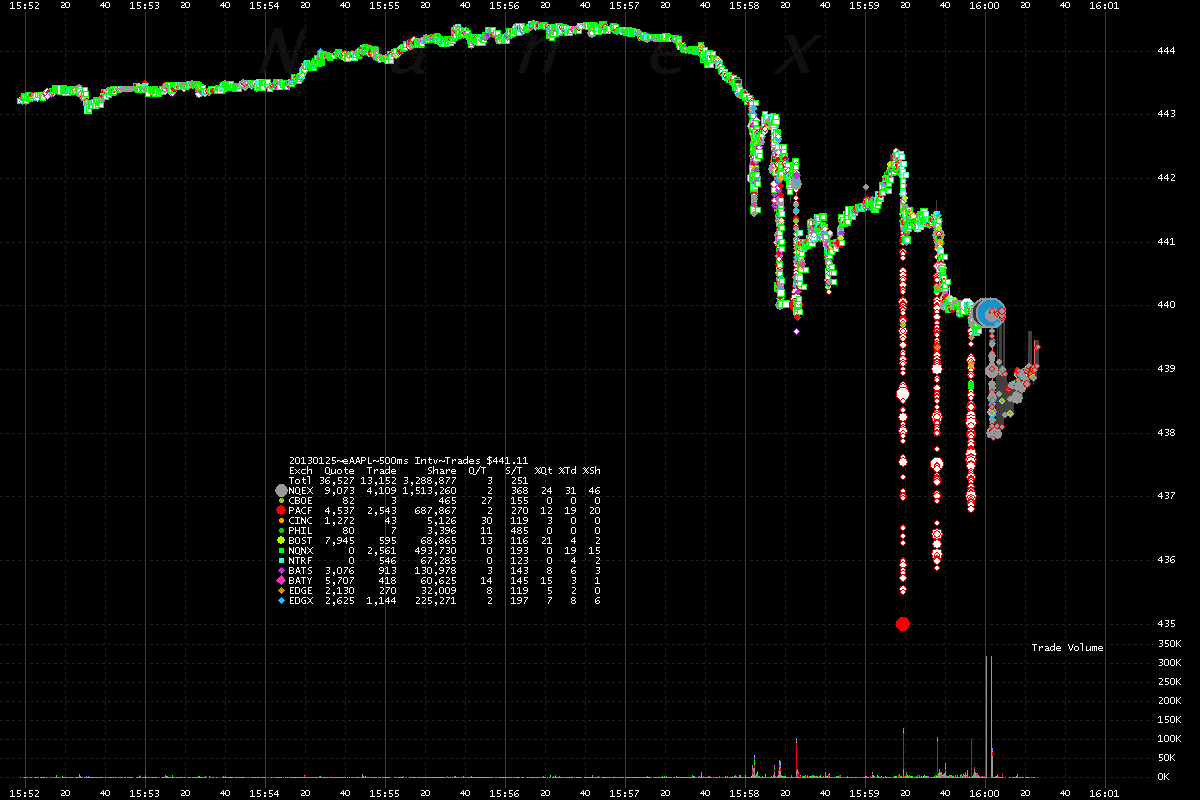While pundits have taken it upon themselves to explain that investors were "disappointed" with Apple after it delivered its results last week, evidence points to "a premeditated flash dump" enable by high frequency trading algorithms.
A report by Philip Elmer-DeWitt, writing for Fortune, cited a blog entry by trading insider 'Tyler Durden,' which noted Nanex charts (one shown below) indicating trades of 800,000 Apple shares worth almost $300 million executed in 17 second intervals.
"In this case," the trader noted, "it looks like a very premeditated unloading" of Apple stock "in the last second, with the full knowledge it would shake the market. Why anyone would want (or wait until the very last second) to do that, while covering the offsetting ES short in the pair trade, to ramp the market into the close, is anyone's guess."
A variety of financial bloggers have offered an alternative explanation for Apple's decline, suggesting that investors collectively believe the company has run out of growth prospects. They point to the company's ostensibly flat quarterly earnings, as reported in comparison to the quarterly income statements from last year.
An apples and oranges comparison of quarters
However, Apple's earnings for the winter quarter of 2012, as Apple's executives have repeated called attention to before, both during and after last year's earnings, involved an extra, 14th week. This extra week is added to Apple's fourth calendar quarter (Apple's fiscal Q1) every five or six years.
Subsequently, as explained by Robert Paul Leitao in "The Mysterious Case of Apple's Missing Growth," this year's quarterly report effectively hid billions in new revenue relative to the previous year's quarter.
"On a weekly basis," Leitao wrote, "Apple's revenue was $4.2 billion in the recent December quarter versus $3.3 billion in the prior-year period. On an equal week basis, revenue in the quarter rose 26.7%."
The report added, "most observers look to the income statement to determine the company's growth. However, Apple's balance sheet that accompanied the December quarter revenue and earnings numbers tells a much different story. It's not so much that Apple's rates of growth have declined, it's an issue of discovering where the current rates of growth are reported."
More invisible billions within Apple
Leitao drew attention to Apple's sizable $132 billion cash pile, on top of the $2.5 billion distribution to shareholders and $2 billion allocated to the company's stock buyback plan.
But he also drew attention to other billions that aren't always considered by investors looking at Apple's operations. Apple continues to defer revenue for Mac and iOS devices it has sold in order to provide free software updates over the course of those products.
At the end of 2012, "Apple's deferred revenue balance totaled $7.274 billion," Leitao noted. "Most of this deferred revenue balance will be recognized as net sales over the next eight fiscal quarters."
Apple also declares US tax expenses on its cash holdings in advance, even though it doesn't have to pay those taxes until it chooses to bring those earnings into the US. "In the December quarter, Apple deferred $1.179 billion in income tax expense," resulting in a total of $14.712 billion in tax expenses that Apple has preallocated, but not actually paid.
"Should a sizable portion of these dollars be repatriated," Leitao stated, "it would not trigger additional tax expense. It would trigger the payment of taxes already recognized as tax expense in past quarterly periods."
He concluded, "The balance sheet will tell a different story than the quarterly income statements for the first half of the current fiscal year. As gross margin improves over the next few quarters and Apple aligns supply with continuing product demand, Apple's underlying rates of growth in FY2013 will become more clear."
 Daniel Eran Dilger
Daniel Eran Dilger







-m.jpg)






 Malcolm Owen
Malcolm Owen
 Christine McKee
Christine McKee
 William Gallagher
William Gallagher
 Amber Neely
Amber Neely

 Andrew Orr
Andrew Orr



-m.jpg)




68 Comments
They'll be regretting it long before the end of 2014.
I'll be interested in seeing what the other big players offer up in the same time frame.
Another attempt to pump people about Apple's stock. When wall street want the stock to go up, it will.
I'm not a market genius but that sounds like stock manipulation to me.
It seems like this would be illegal if you ask me.
An extremely questionable "coincidence" was posted by the Wall Street Journal - I speculate this is the real reason WHY the Dump of Apple stock happened the last second - Big brokerages were selling "Apple Bonds". If the price TANKED then bondholders, who were giving a 10% return supposedly, would instead be paid with Apple shares .. i understand based on the price you paid at the time you purchased the Apple Bond. Net result - if the dumping party could cause the stock to tank the very last second so it could not pop up before close (which is what happened), then Brokerages issuing the Apple Bonds make what, 10s or hundreds of millions? A big brokerage person tried to sell me this .. I vaguely listened at the time... how many "conservative" big brokerage customers thought they were safe rather than buying the stock??? The stock will bounce big time. I think this whole crash this week was driven by brokerages - big guys - with these crazy instruments .. standing to make tens / hundreds of millions if they could cause the stock to crash until last Friday. Here is the link to the WSJ: http://online.wsj.com/article/SB10001424127887323854904578263941939124314.html